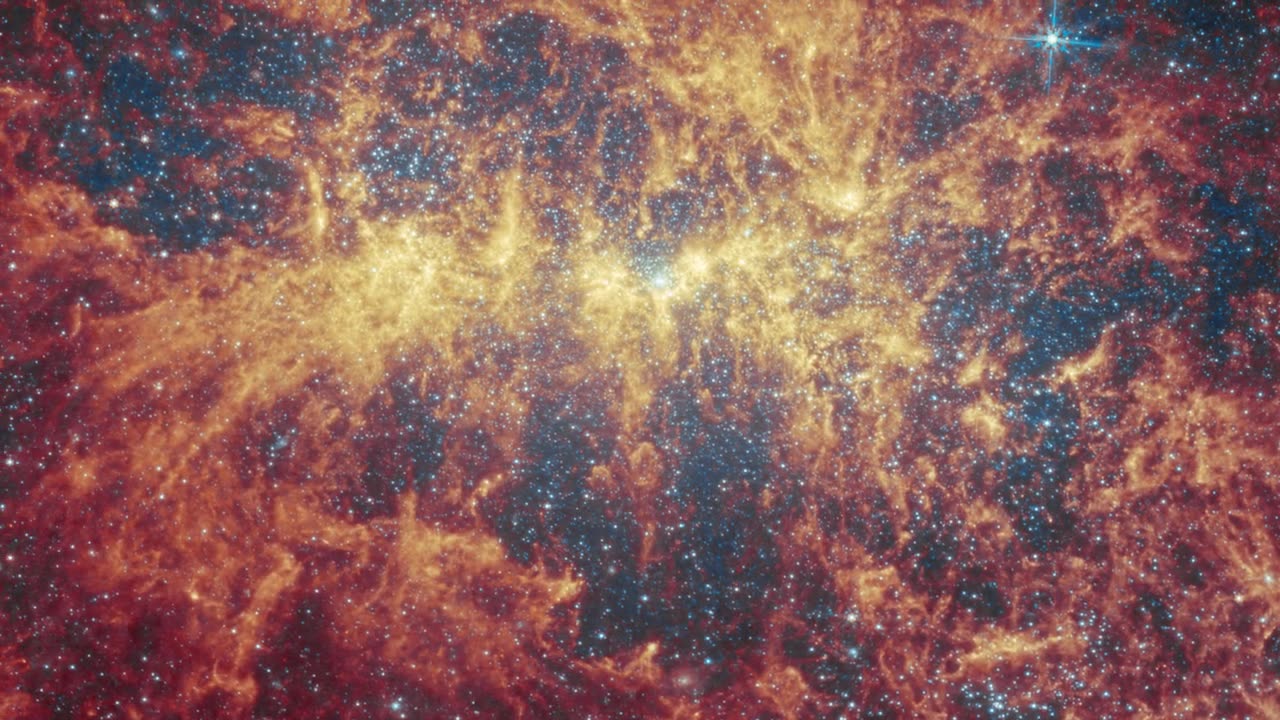Premium Only Content

Pan: NGC 4449 (MIRI image)
Featured in this new image from the NASA/ESA/CSA James Webb Space Telescope is the dwarf galaxy NGC 4449. This galaxy, also known as Caldwell 21, resides roughly 12.5 million light-years away in the constellation Canes Venatici. It is part of the M94 galaxy group, which lies close to the Local Group that hosts our Milky Way.
NGC 4449 has been forming stars for several billion years, but it is currently experiencing a period of star formation at a much higher rate than in the past. Such unusually explosive and intense star formation activity is called a starburst and for that reason NGC 4449 is known as a starburst galaxy. In fact, at the current rate of star formation, the gas supply that feeds the production of stars would only last for another billion years or so. Starbursts usually occur in the central regions of galaxies, but NGC 4449 displays more widespread star formation activity, and the very youngest stars are observed both in the nucleus and in streams surrounding the galaxy. It's likely that the current widespread starburst was triggered by interaction or merging with a smaller companion; indeed, astronomers think NGC 4449's star formation has been influenced by interactions with several of its neighbours.
NGC 4449 resembles primordial star-forming galaxies which grew by merging with and accreting smaller stellar systems. Since NGC 4449 is close enough to be observed in great detail, it is the ideal laboratory for astronomers to study what may have occurred during galaxy formation and evolution in the early Universe.
This image was captured with Webb’s MIRI, or the Mid-InfraRed Instrument, makes observations in the mid-infrared, which spans wavelengths of light very different from visible light the wavelengths that human eyes are sensitive to, which extend from about 0.38 to 0.75 micrometres (a micrometre, or micron, is one thousandth of a millimetre). By contrast, MIRI detects light between 5 and 28 micrometres. However, it does not typically observe across this entire wavelength range all at once. Instead, MIRI has a set of ten filters that allow very specific regions of light through. For example, one of MIRI’s filters used in this image (named F770W), allows light with wavelengths from 6.581 to 8.687 micrometres to pass through it.
This MIRI image reveals the galaxy’s creeping tendrils of gas, dust and stars. The bright blue spots reveal countless individual stars, while the bright yellow regions that weave throughout the galaxy indicate concentrations of active stellar nurseries, where new stars are forming. The orange-red areas indicate the distribution of a type of carbon-based compounds known as polycyclic aromatic hydrocarbons (or PAHs) — the F770W filter is particularly suited to imaging these important molecules.
Credit: ESA/Webb, NASA & CSA, A. Adamo (Stockholm University) and the FEAST JWST team, N. Bartmann (ESA/Webb)
Music: Stellardrone - Maia Nebula
-
 6:29
6:29
BIG NEM
17 hours agoCultivating God Mode: Ancient Taoist NoFap Practices
6.69K1 -
 30:53
30:53
Uncommon Sense In Current Times
1 day ago $0.52 earned"Pardon or Peril? How Biden’s Clemency Actions Could Backfire"
12.2K -
 40:01
40:01
CarlCrusher
15 hours agoSkinwalker Encounters in the Haunted Canyons of Magic Mesa - ep 4
11.3K2 -
 59:44
59:44
PMG
1 day ago $1.28 earned"BETRAYAL - Johnson's New Spending Bill EXPANDS COVID Plandemic Powers"
30.7K1 -
 6:48:50
6:48:50
Akademiks
14 hours agoKendrick Lamar and SZA disses Drake and BIG AK? HOLD UP! Diddy, Durk, JayZ update. Travis Hunter RUN
156K27 -
 11:45:14
11:45:14
Right Side Broadcasting Network
9 days agoLIVE REPLAY: TPUSA's America Fest Conference: Day Three - 12/21/24
340K28 -
 12:19
12:19
Tundra Tactical
14 hours ago $12.74 earnedDaniel Penny Beats Charges in NYC Subway Killing
62.8K12 -
 29:53
29:53
MYLUNCHBREAK CHANNEL PAGE
1 day agoUnder The Necropolis - Pt 1
153K51 -
 2:00:10
2:00:10
Bare Knuckle Fighting Championship
3 days agoCountdown to BKFC on DAZN HOLLYWOOD & FREE LIVE FIGHTS!
54K3 -
 2:53:01
2:53:01
Jewels Jones Live ®
1 day agoA MAGA-NIFICENT YEAR | A Political Rendezvous - Ep. 103
148K36